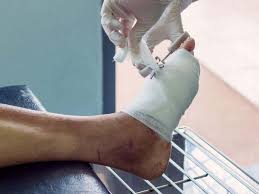Researchers have developed a novel nanoflower-coated bandage that could revolutionize wound care by promoting healing and preventing infections. According to a recent study published in ACS Applied Bio Materials, these bandages exhibit antibiotic, anti-inflammatory, and biocompatible properties, making them promising candidates for treating infections and inflammatory conditions.
The Science Behind Nanoflower Bandages
Nanoflowers are tiny, self-assembling structures with a large surface area, allowing for the attachment of drug molecules. This feature makes them particularly suitable for medication delivery. In this study, researchers Fatemeh Ahmadpoor, Pier Francesco Ferrari, and their colleagues selected copper(II) phosphate and tannic acid as key components due to their known antibacterial and anti-inflammatory properties.
To create the bandages, the research team grew nanoflowers in a saline solution and then integrated them into electrospun nanofiber fabric. Laboratory tests demonstrated that the nanoflower-coated dressings effectively inactivated a broad spectrum of bacteria, including E. coli, Pseudomonas aeruginosa, and Staphylococcus aureus, as well as their antibiotic-resistant biofilms. Additionally, these dressings scavenged harmful reactive oxygen species and did not damage lab-grown human cells, highlighting their biocompatibility.
Potential Impact on Medical Treatments
The research team suggests that these nanoflower-coated bandages could redefine treatment standards by offering a natural, cost-effective, and highly efficient solution for combating infections and accelerating wound healing. With further studies and clinical trials, this innovative approach may lead to the development of more effective wound care products.
The study received funding from the Italian Ministry of University and Research, reinforcing the significance of continued investment in medical nanotechnology.
Disclaimer
While these findings are promising, the nanoflower-coated bandages are still in the experimental phase and have not yet undergone clinical trials in humans. Further research and regulatory approvals are required before they can be commercially available for medical use. Patients should consult healthcare professionals for appropriate wound care treatments currently approved by medical authorities.











